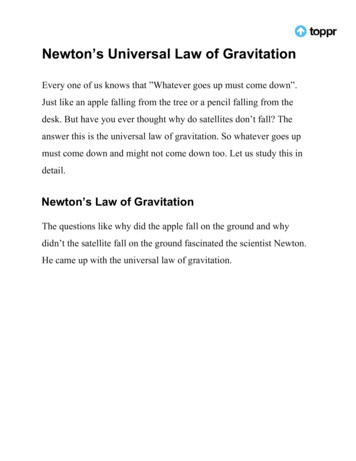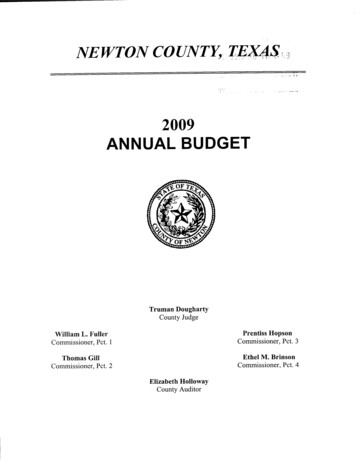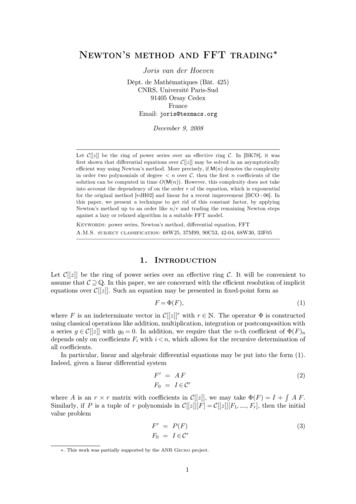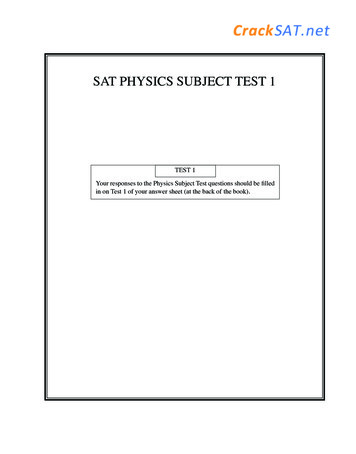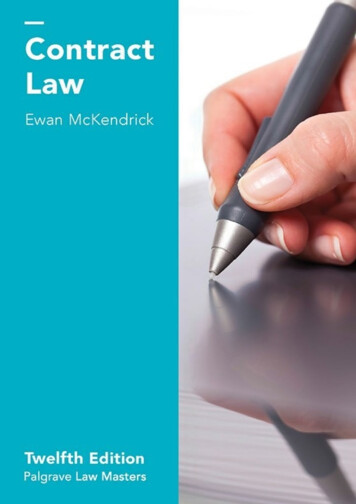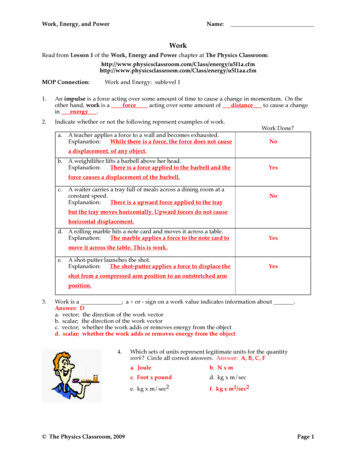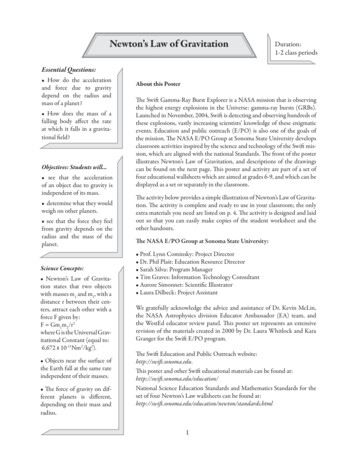
Transcription
Newton’s Law of GravitationDuration:1-2 class periodsEssential Questions: How do the accelerationand force due to gravitydepend on the radius andmass of a planet? How does the mass of afalling body affect the rateat which it falls in a gravitational field?Objectives: Students will see that the accelerationof an object due to gravity isindependent of its mass. determine what they wouldweigh on other planets. see that the force they feelfrom gravity depends on theradius and the mass of theplanet.Science Concepts: Newton’s Law of Gravitation states that two objectswith masses m1 and m2, with adistance r between their centers, attract each other with aforce F given by:F Gm1m2/r2where G is the Universal Gravitational Constant (equal to:6.672 x 10-11Nm2/kg2). Objects near the surface ofthe Earth fall at the same rateindependent of their masses. The force of gravity on different planets is different,depending on their mass andradius.About this PosterThe Swift Gamma-Ray Burst Explorer is a NASA mission that is observingthe highest energy explosions in the Universe: gamma-ray bursts (GRBs).Launched in November, 2004, Swift is detecting and observing hundreds ofthese explosions, vastly increasing scientists’ knowledge of these enigmaticevents. Education and public outreach (E/PO) is also one of the goals ofthe mission. The NASA E/PO Group at Sonoma State University developsclassroom activities inspired by the science and technology of the Swift mission, which are aligned with the national Standards. The front of the posterillustrates Newton’s Law of Gravitation, and descriptions of the drawingscan be found on the next page. This poster and activity are part of a set offour educational wallsheets which are aimed at grades 6-9, and which can bedisplayed as a set or separately in the classroom.The activity below provides a simple illustration of Newton’s Law of Gravitation. The activity is complete and ready to use in your classroom; the onlyextra materials you need are listed on p. 4. The activity is designed and laidout so that you can easily make copies of the student worksheet and theother handouts.The NASA E/PO Group at Sonoma State University: Prof. Lynn Cominsky: Project Director Dr. Phil Plait: Education Resource Director Sarah Silva: Program Manager Tim Graves: Information Technology Consultant Aurore Simonnet: Scientific Illustrator Laura Dilbeck: Project AssistantWe gratefully acknowledge the advice and assistance of Dr. Kevin McLin,the NASA Astrophysics division Educator Ambassador (EA) team, andthe WestEd educator review panel. This poster set represents an extensiverevision of the materials created in 2000 by Dr. Laura Whitlock and KaraGranger for the Swift E/PO program.The Swift Education and Public Outreach website:http://swift.sonoma.edu.This poster and other Swift educational materials can be found at:http://swift.sonoma.edu/education/National Science Education Standards and Mathematics Standards for theset of four Newton’s Law wallsheets can be found rds.html1
Description of the Front of the Poster:Solar system: All the planets in the solar system orbit the Sun due to its gravity. The inner planets are closer to theSun and feel more gravity, so as a result they move faster.Astronaut: Gravity goes on forever; an astronaut in orbit is accelerated by Earth’s gravity. But without the balancing upward force from the ground, she falls freely. Some people call this “weightlessness”, but that’s not really true.“Free fall” is a better term.Newton: Isaac Newton was the person who realized that all massive objects in the Universe apply the force of gravity to all other massive objects. An apple didn’t really fall on his head, but he did realize that the force causing anapple to fall is the same as the force causing the Moon to orbit the Earth – the Earth’s gravity.Girl falling: While falling, a girl feels a brief period of “free fall” while she is in the air because the Earth’s gravityis not balanced by any upwards force. The gravity due to the girl’s mass applies the same force on the Earth as theEarth’s gravity does on the girl, but because the Earth has so much more mass it does not accelerate very much atall, while the girl accelerates rapidly.Bike: Bicyclists climbing a hill – or speeding down one – are certainly aware of gravity!Swift orbiting Earth: The effect of Swift’s horizontal velocity (from its launch rocket) exactly cancels the downwardvelocity gained from the acceleration due to Earth’s gravity. This gives Swift its circular path around the Earth. See“Newton’s law of Gravitation and the Swift Satellite” below.Background Information for Teachers:Newton’s Laws of Motion and the Law of Gravitation.It is well-known today that the force of gravity an objectfeels depends on a relatively simple relationship:F GmMr2The derivation of Newton’s Law of Gravitationis beyond the scope of this activity. However, ifyou want to see it, it can be found on the Swiftsite: http://swift.sonoma.edu/education/newton/newton 4/derivation.htmlwhere F is the force of gravity, M is the mass of one object, m is the mass of a second object, r is the distance betweenthem, and G 6.672 x 10-11Nm2/kg2 is a constant called Newton’s Universal Gravitational Constant.This relationship governs the motion of the planets in their orbits, guides spacecraft to their destinations, and evenkeeps our feet firmly on the ground. Sir Isaac Newton derived this equation in the 17th century but it is still usefultoday.When you teach students science, they love to ask, “How does this affect me?” For once, you can answer this honestly: this directly affects them. It affects everything! In fact, we can use Newton’s equation to figure out just howhard the Earth is pulling us.GmMF Look again at the equation.r2We know that F ma from Newton’s Second Law of Motion. We can set that equal to the equation above, and solvefor a, the acceleration due to Earth’s gravity:a G ME / RE2where ME is the mass of the Earth and RE is its radius. We know the values of all these numbers:G 6.672 x 10-11 N m2/kg2ME 5.96 x 1024 kgRE 6375 km2
Substituting those into the equation above, we see that the acceleration due to gravity for any object on theEarth’s surface (usually called g or “little g”) is 9.8 m/sec2. In other words, an object dropped near the Earth’ssurface will accelerate 9.8 m/sec for every second it falls: it will move at a velocity of 9.8 m/s after the firstsecond, 2 x 9.8m/sec 19.6 m/sec the next, 3 x 9.8m/sec 29.4 m/sec the next, and so on.This equation has a very important implication: the mass of the object falling doesn’t matter! A grape and agrand piano will both fall at the same acceleration, and therefore the same velocity (if they both drop fromthe same height). This is counter-intuitive to most people, including, most likely, your students. Our intuition tells us that more massive objects fall faster, but that is not correct.Students may be confused by this because they know that more massive objects weigh more. While this istrue, it is important to distinguish between weight and mass. Mass is intrinsic to matter, but weight is theforce of gravity on that mass. Remember, F ma. The acceleration due to gravity does not depend on themass of the object falling, but the force it feels, and thus the object’s weight, does.This tells us two things. One is that the speed at which an object falls does not depend on its mass. Thesecond is that if the acceleration due to gravity were different (say, on another planet) you’d weigh a differentamount. These two concepts are the basis of the classroom activities.Additional Background Information for Teachers:Sir Isaac Newton (1642-1727) established the scientific laws that govern 99% or more of our everyday experiences. He also explained our relationship to the Universe through his Laws of Motion and his UniversalLaw of Gravitation. These are considered by many to be the most important laws in all physical science.Newton was the first to see that such apparently diverse phenomena as an apple falling from a tree, theMoon orbiting the Earth, and the planets orbiting the Sun operate by the same principle: force equals massmultiplied by acceleration, or F ma.Our everyday lives are influenced by different forces: for example, the Earth exerts a force on us that we callgravity. We feel the force required to lift an object from the floor to a table. But how exactly does Newton’sSecond Law of Motion relate to gravity? To understand Newton’s Law of Gravitation, you must first understand the nature of force and acceleration when applied to circular motion, rather than motion in a straightline.Newton’s First Law of Motion tells us that, without the influence of an unbalanced force, an object willtravel in a straight line forever. This means that an object traveling in a circular path must be influenced byan unbalanced force. The circulating object has a velocity that is constantly changing, not because its speedis changing, but because its direction is changing. A change in either the magnitude (amount) or the direction of the velocity is called acceleration. Newton’s Second Law explains it this way: A net force changes thevelocity of an object by changing either its speed or its direction (or both.)Therefore, an object moving in a circle is undergoing acceleration. The direction of the acceleration is towardthe center of the circle. The magnitude of the acceleration is a v2/r, where v is the constant speed along thecircular path and r is the radius of the circular path. This acceleration is called centripetal (literally, “centerseeking”) acceleration. The force needed to produce the centripetal acceleration is called the centripetalforce, Fcent macent, according to Newton’s Second Law. So therefore the centripetal force can be written asFcent macent mv2/r3
Majestic examples of circular motion can be found throughout our Universe: Planets orbit around the Sun innearly circular paths; moons orbit around their planets in nearly circular paths; and man-made satellites (such asSwift) can orbit the Earth in nearly circular paths.Pre-Activity Reading:Newton’s Law of Gravitation and the Swift SatelliteIn our previous Newton’s Law posters, we examined what happened when Swift was launched in the rocket andwhat happens as the rocket burns its fuel. We also studied the forces acting on Swift as it went into orbit. In thisfinal poster we will study the relationship between the gravitational force on Swift and its acceleration and velocity.Recall that as Swift enters its orbit, it has velocity that is purely “horizontal” – that is, it is moving parallel to thecurved surface of the Earth at each point. However, the force of the Earth’s gravity on Swift is “vertical” – pointedtowards the center of the Earth. Why then does Swift not fall to Earth immediately? The answer is that Swiftmoves horizontally at just the right rate so that as it falls vertically, its motion creates a circular path around theEarth. This balance between “horizontal” and “vertical” motion is what is meant by “being in orbit.” Swift willbe able to stay in orbit for many years, as long as its horizontal velocity is maintained at a high enough rate. Thespecial relationship between the horizontal velocity and the gravitational acceleration for any body that is orbiting another more massive body was worked out by Johannes Kepler years before Sir Isaac Newton figured out theLaw of Universal Gravitation.Eventually, the cumulative effect of the small number of atmospheric molecules hitting Swift in its orbit 600 km aboveEarth will cause the “horizontal” motion of the satellite to slow down; its horizontal motion will noVhorlonger be able to completely counteract its vertical motion. When this happens, Swift’s orbitacentwill start to “decay.” As Swift spirals in closer tothe Earth there will be even more atmosphericdrag, which will cause Swift’s orbit to decayincreasingly faster. Swift will end its life plunging in through the Earth’s atmosphere, probably sometime around The relationship between the velocity and acceleration ofSwift in itsMaterials:orbit is shownto the left and Several objects of differentalso on the front ofmasses and sizes, such as pencils,the poster (not to scale).crumpled up aluminum foil,Procedure for In Class Activities: Newton’s Law of Gravitationcoins, fishing weights, etc. Makesure they are not breakable! CalculatorIn these two activities, your students will investigate Newton’s Law of Gravitation. In the first activity, you can divide them into teams to experimentally investigate the fact that the acceleration of an object due to gravity isindependent of its mass. In the second activity (for advanced students),they can work individually or in pairs to calculate how their weight would change on other bodies in the solarsystem, and to see that the force due to gravity, and hence their weight, depends on the radius and mass of theplanet.4
Part A: The Fall of ManYour students will be dropping various objects to the floor to see if they fallat different rates. Go over the background material to the level you think isappropriate for your class, but do not go over the concept that accelerationis independent of the mass of the falling object! They will find this out forthemselves in the first part of the activity. When you give them materialsto test, make sure they have different sizes, masses, and densities. Make surethey are not breakable! Also, make sure they won’t be affected too much byair resistance; a balloon or a piece of paper won’t work (although crumpledpaper will if it is wadded up tightly).After this activity, discuss the results with the students. Most likely, theywill have predicted that the heavier object will hit first and found that thisis not true; the two objects fell together at the same rate. Explain to themthat this is because the acceleration due to gravity is independent of mass.Some students may have a hard time internalizing this. They may even disagree with the results. If that happens, demonstrate the activity for themagain from a higher elevation (standing on a chair, for example), using verydifferent mass objects (like a pencil and a heavy weight).Hint:Students may get stuck on Question 3, where they try to think ofthings that may have thrown offtheir timing. The two largest factors in this are human reactiontime and air resistance. If they getstuck, ask them to drop a penciland an unfolded sheet of paper.Then have them repeat the experiment, but this time with a penciland a tightly wadded piece ofpaper. Ask them why the waddedpaper fell faster, and they shouldsee that air resistance slowed thepaper the first time.Part B: The Gravity of the Situation (Advanced Students)Before doing Part B, remind them of the difference between acceleration and force. Go over Newton’ s law ofgravitation, and stress the idea that the acceleration due to gravity on a planet’s surface depends on the planet’s sizeand mass, and that this means that they would have different weights on different planets. Review the derivationof “little g” that is given in the background information, and perhaps work one example for a different planet, sothat they will understand how to proceed. You may also wish to use the questions in the box “Think About It!” asthe basis for class discussion after the table is completed.The students might be a little confused over the units for all these numbers (like G 6.672 x 10-11 N m2/kg2). Thisis understandable! If they get confused, tell them that to complete the activity they only need to worry about thevalues of the numbers. The units are important when doing science, but for now they can just use the numbers.Extension Activity - Swift Orbit (Advanced students):The following activity is beyond the normal scope of this poster, but may interest advanced students. It may helpto let them read the derivation of Newton’s Law of Gravitation at:http://swift.sonoma.edu/education/newton/newton 4/gravitation.html. You might have to explain the math tothem first.a) Use Kepler’s Law: T2 K R3 to calculate the period of the Swift satellite in its 600 km orbit around the Earth.The period, T, is how long it takes for Swift to orbit once around the Earth. Remember that the distance, R, in thisequation is measured from the center of the Earth, and that the Earth’s radius is about 6375 km. The constant Kin this equation is equal to (4π2) / (GME ), where ME is the mass of the Earth, and is equal to 5.96 x 1024 kg, andG is the gravitational constant: G 6.67 x 10-11N m2/kg2.b) What is Swift’s velocity in its orbit? Recall that v 2πR/T.c) If Swift’s weight in orbit is 1255 kg, (see “Think About It!” part “e” on p. 8) why then do we refer to astronautsorbiting the Earth as “weightless”?5
Answer for Extension Activity:a) K 9.931 x 10-14 s2 m-3R 6375 600 km 6.975 x 106 mTherefore, T 5805 seconds or 96.7 minutesb) v 7550 m/sec (about 25 times thespeed of sound)c) Astronauts are not really weightless in orbit. In fact, they weigh at least 85% of their weight on Earth. The effect thatis usually called “weightlessness” is more correctly called “free fall.” The astronauts are falling towards the Earth (moving“vertically”) at the same rate as their space vehicle travels “horizontally,” so they never actually fall to the Earth. You canexperience free fall without leaving the Earth – just try jumping off a diving board or into the air. You will feel “weightless” until you hit the surface of the pool or the ground.Assessment:PointsPart A: The Fall of ManPart B: Gravity of the Situation4A) Student is able to predict the motion of objectsfalling to the ground B) Student is able to makerepeatable measurements of falling objects C)Student is able to thoughtfully consider the initialpredictions and revise them, if incorrect D) Student is able to correctly conclude that mass has noeffect on accelerationA) Student is able to correctly calculate the accelerations for allthe solar system bodies listed in the table B) Student is able tocorrectly calculate all the ratios of the accelerations with respectto that of Earth C) Student is able to thoughtfully consider theresults of the calculations and provide correct answers aboutMercury, Jupiter and the Moon D) Student is able to correctlydescribe the difference between mass and weight3Student achieves the first three objectives above.Student achieves the first three objectives above.2Student achieves the first two objectives above.Student achieves the first two objectives above or at least half ofthe first two objectives and the third objective.1Student achieves only the first objective above.Student achieves only the first objective above or parts of thefirst two objectives0Student achieves none of the objectives above.Student achieves none of the objectives above.Answers to In-Class Activity Questions:Part A: The Fall of Man1) Most students will predict the heavier object will hit first.2) They should find that the objects hit at the same time.3) This answer will depend on their prediction. Reasons the experiment might be thrown off could be that they didn’tlet go of the objects simultaneously, that the person viewing the impact didn’t see it clearly, or that air resistance slowedone of the objects more than the other.4) Many may change their prediction, saying both will hit simultaneously.5) Most people are surprised that objects with very different masses will fall at the same rate.Part B: The Gravity of the SituationPlanet NameMass (kg)Radius (m)Acceleration(m/sec2)Acceleration compared to EarthMercury3.3 x 10232.4 x 1063.80.39Venus4.9 x 106.1 x 1068.90.90Earth6.0 x 106.4 x 1069.81.0Moon7.4 x 101.7 x 1061.70.17Mars236.4 x 103.4 x 1063.70.38Jupiter1.9 x 10277.1 x 10723.12.4Saturn5.7 x 10266.0 x 10790.92Uranus8.7 x 10252.6 x 10790.91Neptune1.0 x 10262.5 x 107111.1Pluto1.3 x 10221.2 x 1060.600.0622424226
Name:Student Handout:Newton’s Law of GravitationDate:Period:You already know about gravity: it holds you down to the Earth. But there is more to gravitythan that! In this activity you will investigate a few properties of gravity and see how it affectsyou – not just on Earth, but on other planets!The goal of Part A is to determine the relationship between the acceleration due to gravity andthe mass of an object. The goals of Part B are to determine how much you would weigh onother planets and how that weight is affected by the mass and radius of the planet.Part A: The Fall of ManCount backwards from three, and on “zero”drop the objects at the same time. Did onehit first? If so, which one? Note what happened on your worksheet. Repeat the procedure at least twice more to make sure youget consistent results.1) Your teacher has supplied you with a collection of different objects. Look over them:are they all the same size, the same weight?Pick two of the objects that have differentweights and sizes. They should be differentenough that you can easily feel the difference.If they are dropped from the same height, willone hit the floor first, or will they hit at thesame time? Make a prediction about this, andrecord it.3) Was your prediction accurate? Why orwhy not? Can you think of any ways yourexperiment might have been thrown off ?Explain.4) Now find two objects that are roughly thesame size, but very different weights. Repeatthe experiment, and again record your prediction and the results.2) Now take the objects and hold them infront of you. Make sure the bottoms of theobjects are the same height from the floor.Have another student kneel or lie down onthe floor in front of you so they have a goodview of where the objects will land.5) Did the results surprise you? Why or whynot?Part B: The Gravity of the Situation (Advanced students):Newton’s model of gravity is one of the most important scientific models in history. It appliesto apples falling from trees, baseballs soaring into the outfield, and milk being spilled in yourschool cafeteria. The exact same model applies to other planets in our Solar System, too!Use the Solar System table given on p.8 to determine the value of g, the acceleration due to gravity, for each of the other planets in the Solar System.Use the equation for acceleration in the box and theg GM/R2values for the masses and radii of the planets listed inthe table. Complete the third column of the table withwhere M mass, R radius,and G 6.672 x 10-11 N m2/kg2the value for the surface gravitational acceleration foreach planet (and the Moon).7
Part A: The Fall of Man - Answer the following(use a separate sheet of paper if necessary):4. Observations of second experiment:1. My predictions:2. This is what I observed:5. Were you surprised? Why or why not?3. Accurate predictions?Part B: The Gravity of the Situation - Complete the solar system data chart:Planet NameMass (kg)Radius (m)Mercury3.3 x 10232.4 x 106Venus4.9 x 10246.1 x 106Earth6.0 x 10246.4 x 106Moon7.4 x 10221.7 x 106Mars6.4 x 10233.4 x 106Jupiter1.9 x 10277.1 x 107Saturn5.7 x 10266.0 x 107Uranus8.7 x 10252.6 x 107Neptune1.0 x 10262.5 x 107Pluto1.3 x 10221.2 x 106Acceleration (m/sec2)Acceleration compared to Earth9.8 m/sec21Think about it!Once you complete the third column, you can see how strong(or weak) gravity is on other planets. A better way toa. Would you weigh more or less onMercury than you do on Earth?understand this is to compare the gravity of the planetsb. How about Jupiter?with the Earth’s. So in the last column, divide the gravityyou got for the other planets by the Earth’s gravity (forc. How much would you weigh on the Moon?example, after you do this, you will get the Earth’s gravd.What is the difference between mass and weight?ity 1, since you are dividing the number you got fore. If Swift weighs 1500 kilograms on the surface ofEarth’s gravity by itself ).the Earth, how much does it weigh at an orbit of600 km above the Earth’s surface?8
Answers to Think About It!a) You would weigh less on Mercury than on the Earth. (The “g” factor is 0.39 times that of Earth.)b) You would weigh more on Jupiter than on the Earth. (The “g” factor is 2.4 times that of Earth.)c) On the Moon, you would weigh 0.17 times your weight on Earth, or about 1/6 as much.d) Mass is the amount of “stuff ” in an object, and weight is the result of the force of gravity acting on thatamount of stuff. When you go to a different planet, you look the same (mass) but your weight will change,depending on the changes in the gravitational force.e) The value of “g” in Swift’s orbit is 8.2 m/sec2 compared to 9.8 m/sec2 on the surface of the Earth. Swift wouldtherefore weigh 1500 kg x (8.2/9.8) 1255 kg in orbit.References for all Four Posters:Copies of these materials, along with additional information on Newton’s Laws of Motion and Law ofGravitation, are available on the Swift Mission Education and Public Outreach Web site:http://swift.sonoma.edu/ NASA Web sites:NASA’s official Web site - http://www.nasa.govSwift Satellite - http://swift.gsfc.nasa.gov NASA Education Resources:Imagine the Universe! - http://imagine.gsfc.nasa.govThe Space Place - http://spaceplace.nasa.govImagine the Universe! - http://imagine.gsfc.nasa.gov NASA’s Central Operation of Resources for Educators ome/index.htmlCheck out these videos:“Liftoff to Learning: Newton in Space” (1992), 15.00“Flight Testing Newton’s Laws” (1999), 24.00 NASA’s Space Science Education Resource Directory:http://teachspacescience.org Newton’s Laws of ewton.html Newton’s Law of t/history/newtongrav.html Newton in the /gbssci/phys/Class/newtlaws/u2l1a.html The Nine .sonoma.edu
Therefore, an object moving in a circle is undergoing acceleration. The direction of the acceleration is toward the center of the circle. The magnitude of the acceleration is . a v 2/ , where v is the constant speed along the r circular path and r is the radius of the circular path. Thi
